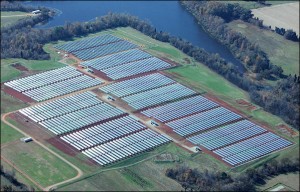Want to see more solar energy in Virginia? There many ways to tackle the challenge. One that typically gets overlooked is for local governments to amend their zoning ordinances to be friendlier to larger scale (transmission scale) solar generation of electricity.
Solar power can be generated either for private use on a property, through a net metering arrangement that allows for sale of small quantities of power to be sold to the electric grid, or through a large-scale array that dispatches electricity to transmission lines. The third use, transmission scale, is best suited for locations near existing transmission lines and substations where voltage exceeds 138 kilovolts. Typically, projects require an adjacent substation that raises electrical voltage to match the transmission line’s voltage. (Transmission lines are the wires suspended from tall towers that convey power from power plants, often across state boundaries, as opposed to the shorter, more ubiquitous power lines.)
The right kind of zoning ordinance can simplify the adoption of large-scale solar projects connected to the transmission grid. When Amazon Web Services recently announced plans to build a solar farm in Accomack County, the local zoning ordinance explicitly recognized solar power generation and provided a predictable permit approval process. Accomack is one of three counties, along with Northampton and Clarke County, that has amended its zoning ordinance in the past five years to accommodate transmission-scale solar.
Whether other local jurisdictions are prepared to permit similar transmission- scale solar is less clear. For example, in Loudoun County where I reside, a transmission-scale solar project is permitted only on land that is zoned general industry or heavy industrial use, where any transmission-scale energy project like coal, natural gas, or nuclear is allowed, even though solar generation produces power with less noise, pollution and other side effects than conventional power generation. When added to non-forested open land with gentle slopes, solar power has little if any effect on neighboring parcels, because neither noise nor pollution is generated.
When transmission-scale solar power is bundled with other transmission-scale resources in zoning ordinances, less land within a jurisdiction is deemed eligible for transmission-scale solar development. Potential solar developers endure less predictable, more cumbersome political level approvals from boards of supervisors. Solar developers also must also seek permits from the State Corporation Commission and PJM regional transmission organization, so local permits are not their only hurdle. But the hurdle in Virginia often is higher than it needs to be.
North Carolina has also recognized this hurdle. In December 2013, a diverse working group sponsored by the NC Sustainable Energy Association and North Carolina Solar Center published the “Template Solar Energy Development Ordinance for North Carolina.” The model ordinance provides text to fit smaller scale, residential scale solar approvals; community/commercial solar scale; and the larger, transmission-scale projects described here. Among other details, it addresses maximum suggested height of a ground-mounted module and minimum setbacks, or distances, from neighboring properties. The ordinance template is available to all interested North Carolina jurisdictions and was published after North Carolina had already surpassed Virginia and other neighboring states in solar installations.
Virginia should develop a similar model ordinance that can draw from solar-ready ordinances already adopted in Accomack, Northampton, and Clarke Counties. I believe this would be a worthwhile effort of the newly approved Virginia Solar Energy Development Authority.
William Marsh is a civil engineer who has worked for local government in northern Virginia the last 13 years, currently at Fairfax County. He also owns a rooftop solar array at his home.



